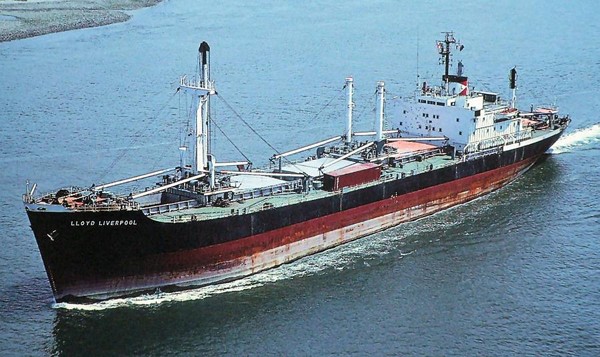Was The World’s ‘Northern-Most Island’ Erased From Charts?
by Kevin Hamilton (University of Hawaii) In 2021, an expedition off the icy northern Greenland coast spotted what appeared to be a previously uncharted island. It was small and gravelly,...


– By Luiz Gustavo Cruz, Contributing Writer, MTS Logistics
The great days of the shipping industry in Brazil were gone a long time ago. Big shipping lines went bankrupt, Brazilian-flagged ships were sold, arrested, abandoned or scrapped, and shipyards had little to no service and were forced to close or stay afloat with minor repairs and dry-docking jobs. The Brazilian shipping industry has a very sad history, but it seems that there is hope for a brighter future for the South Atlantic giant!


The 1960’s and 1970’s were remarkable to the merchant marine history in Brazil. The creation of the “Merchant Marine Fund” and the “Tax for the Merchant Marine Renew”, in 1958, together with other specific targets set by the government at that time, made investments available to the shipbuilding industry and for the development of the merchant marine in general. Counting on such incentives, new shipyards as Ishibras and Verolme were built, old shipyards were renovated and in the late 70’s, the Brazilian ship building industry reached the second position in the world, employing over 40,000 people in 1979, and the country headquartered one of the biggest shipping companies in Latin America, not to say in the world: the former Lloyd Brasileiro.
This positive development was badly hit within the 80’s and 90’s, when the country experienced lots of economic and political problems. The number of employees in shipbuilding decreased to 30,000 within 4 years in 1983 and with the “sinking” of Lloyd Brasileiro in the 90’s after 100 years in service, several Brazilian merchant ships where simply abandoned at anchor as what happened to the former M/V “Lloyd Atlântico”, which was the biggest container ship built in south America in the 80’s and was left at anchor in Rio de Janeiro after only 10 years in service.
With a breakdown in the country’s economy, and public investments being redirected to the building of roads rather than to the development of ports and cabotage, the shipping business almost disappeared in Brazil and companies were one after the other going through financial problems leading to bankruptcy.
The exceptions of this were only seen in big public companies such as Petrobras-Fronape (oil & gas) and Docenave of Vale (mining products) that could keep its fleet operating in a profitable way by transporting their own commodity products worldwide.
In the mid 1990’s, Brazil experienced major changes in its economy as new successful fiscal and economical plans came into force. The Real currency was released, which brought financial stability back to the industry.
After a while, the growing economic influence of the BRIC (Brazil, Russia, India, and China) gained momentum and Brazilian industry started to emerge from its deep sleep. The Chinese took command on almost all manufactured goods, and the worldwide container market rose to the moon, while at the same time, the Brazilian offshore oil & gas industry advanced 50 years in less than a decade.
The old Brazilian shipyards have started to receive new orders as the government gave its contribution once again, developing new specific policies to reactivate the shipping industry in the country. The “M/V Log-in Jacarandá”, for example, was launched in 2010 as the first container ship built in the country in 15 years and new modern tankers for Petrobras have also started to be built. Additionally, Petrobras, has also placed new supply vessels on long term contracts to serve its production fields alongside the Brazilian coast with the condition that these new vessels are built in Brazil. Even new ferry boats connecting the neighboring cities of Rio de Janeiro and Niterói, across the Guanabara Bay, were built and put into service replacing the old ones that were long past their service life.
Brazil still has its problems to deal with however, particularly infrastructure.
The cost to move a container in Brazil is up to 3 times higher than in Hong Kong. Big ships cannot call on most Brazilian ports due to draft restrictions, port clearance takes a lot of time, and the quality of the average port labor is still poor when compared to European ports. A lot is still to be done. New Brazilian cabotage shipping lines such as Log-in LogÃstica were recently formed, and traditional companies like Aliança Navegação e LogÃstica of Hamburg Sud are increasing its investments in Brazil, putting 4 new vessels into service between 2009/10, which increased the company’s TEU’s capacity from 53,180 to 68,885 (+29,5%). Such figures from Aliança are certainly small when compared to market leaders like A.P. Moller – Maersk Line and their new 12,000 TEU’s capacity ships, but looking back to the recent decline of the Brazilian shipping industry, some kind of recovery can be expected to be in progress.
Do you – dear reader – remember that old and abandoned “M/V Lloyd Atlântico” that I mentioned before? Well, after several years left by herself, the ship was sold, refurbished and renamed “M/V Maestra Atlântico”. Now she looks brand new and once again is flying the green and yellow flag of Brazil, calling several ports alongside the Brazilian coast. What is even better is that the ship owner is a new 100% Brazilian-owned shipping company founded in 2010.
Better days are definitely coming for the shipping industry in Brazil!
![]()
![]()
Join the gCaptain Club for curated content, insider opinions, and vibrant community discussions.


Join the 105,918 members that receive our newsletter.
Have a news tip? Let us know.
Access exclusive insights, engage in vibrant discussions, and gain perspectives from our CEO.
Sign Up




Maritime and offshore news trusted by our 105,918 members delivered daily straight to your inbox.



Essential news coupled with the finest maritime content sourced from across the globe.
Sign Up